©
2004 Jeff Matthews & napoli.com
Chinese
restaurants, snow (1)
 “I
tre gioni della merla.” If merla meant “eagle”
or “falcon”—some swashbuckling raptor—then The
Three Days of (name of appropriate winged warrior) might be the
name of a good spy thriller. However, merla is merely the feminine
form of merlo—blackbird—and “The Three Days
of the Female Blackbird” refers to the three days just behind
us, the last three in January, traditionally regarded as the coldest
days of the year. I have read that the basis of this expression is found
in an old Lombard legend, but I haven’t been able to verify this,
myself, since the Lombards haven’t been a power in Italy in 1000
years and are certainly all dead. I do know of a person in Naples whose
name is about as Lombard as you can get without actually being “Lombard”.
It’s “Ostrogoth”. He might know. “I
tre gioni della merla.” If merla meant “eagle”
or “falcon”—some swashbuckling raptor—then The
Three Days of (name of appropriate winged warrior) might be the
name of a good spy thriller. However, merla is merely the feminine
form of merlo—blackbird—and “The Three Days
of the Female Blackbird” refers to the three days just behind
us, the last three in January, traditionally regarded as the coldest
days of the year. I have read that the basis of this expression is found
in an old Lombard legend, but I haven’t been able to verify this,
myself, since the Lombards haven’t been a power in Italy in 1000
years and are certainly all dead. I do know of a person in Naples whose
name is about as Lombard as you can get without actually being “Lombard”.
It’s “Ostrogoth”. He might know.
The legend
was right on this year. The last three days have been the coldest in
Naples since winter started. There was snow on Vesuvius for the first
time; it was spread down about one-third of the slope, meaning that
the snow line must have been at about 2000 feet, low enough to powder
the tops of the hills along the Sorrentine peninsula and all of the
mountains surrounding Naples, itself. It didn’t snow any at sea-level,
but we did get hail, and the temperature was cold enough to keep the
hail on the ground for a while. It covered the walkways along the seafront
and was enough like snow for a short time to enable kids to scoop together
a slush-ball or two.
Speaking
of female blackbirds, this is the first day of the Year of the Goat
in the Chinese lunar calendar. (Indeed, it was too much to hope that
they might actually have A Year of the Blackbird or Crow or Raven or
at least a Year of the Smooth Segue.) It’s time to go down to
the nearby Chinese restaurant and say good-bye to the family that runs
it; they are going back to China after years in Naples. I remember when
there were absolutely no Chinese restaurants in the city. Then, about
20 years ago, they started to roll in. There seemed to be well over
a dozen of them. Then, a lot of them closed. Now there are 3 or 4 that
I know of. Maybe the ones that left simply made enough money to be able
to return home, as is the wish of so many immigrants. Naples and southern
Italy, in general—having sent millions of persons abroad over
the years to seek work and a new life—is now in the unaccustomed
position, itself, of being somewhat of a magnet for immigrants.
San Carlo
(2)—
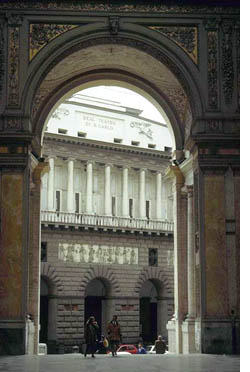 I see that the New
York Times had an item yesterday about the appropriateness of booing
at the opera. In Naples, that is not up for discussion. Let's assume
that you are a lowbrow knuckle-dragging cultural yahoo, the kind of
guy who would have met Mother Theresa and said, "Hey, howya doin', Sister—here,
have a beer!" Then you will be happy to learn that the San Carlo Theater can still can still be as rough
and tumble as it was when Mark Twain was here in 1869. He described
the audience at San Carlo as "…three thousand miscreants…
[with]…all the vile, mean traits there are". I see that the New
York Times had an item yesterday about the appropriateness of booing
at the opera. In Naples, that is not up for discussion. Let's assume
that you are a lowbrow knuckle-dragging cultural yahoo, the kind of
guy who would have met Mother Theresa and said, "Hey, howya doin', Sister—here,
have a beer!" Then you will be happy to learn that the San Carlo Theater can still can still be as rough
and tumble as it was when Mark Twain was here in 1869. He described
the audience at San Carlo as "…three thousand miscreants…
[with]…all the vile, mean traits there are".
[The
entire excerpt on Naples from The Innocents Abroad may be viewed
by clicking here.]
San
Carlo has always been what they called in the days of vaudeville a "tough
house". Far from being the refined types we imagine opera-goers to be—signalling
severe disapproval by lofting their eyebrows into little arches of arrogance
and delicately "aheming" once or twice— Neapolitans boo, whistle
at, and heckle the performers. If the performer is doing all right,
then the public heckle one another, just for something to do. I have
seen them cat–call the scenery when the opening curtain went up,
just to let the singers quivering off–stage know what was in store
for them.
Way back
in 1816, for example, Rossini chose
to premiere his Barber of Seville in Rome instead of Naples although
at the time he was actually in charge of San Carlo. His opera was a
reworking of an already beloved opera of the same name by the popular
Neapolitan composer Giovanni Paisiello.
Rossini, aware that the hometown crowd resented his efforts, thought
that he might escape their wrath by opening away from Naples. It didn't
work. Paisiello fans from Naples—"opera hooligans," to use a more
modern and thoroughly appropriate term—followed him and disrupted
the premiere of what has since come to be regarded as one of the greatest
works of the comic opera genre. And later, in 1901, local critics panned
their own hometown boy, Enrico Caruso,
so severely that he took umbrage and then took himself to America, never
to sing in Naples again.
In the
1960's, the San Carlo audience was so unforgiving to the soprano in
Madame Butterfly, that she gave the whole house the local version
of the "finger"— the "horns," right from center stage. One
time, tenor Franco Corelli actually ran off the stage at San Carlo to
get a heckler. And when the baritone in Pagliacci delivered the
opening line of the opera, a rhetorical question to an on–stage
audience assembled for a carnival: "Si può?" (“May
I begin?”), someone in the real-life audience at San Carlo shouted
"No!" Similarly, a line towards the end of La Boheme
has the tenor singing, "I can no longer stay." Someone in the upper
boxes saw that as a straight line for his own jibe: "So leave!"
And at
the end of the 1991/92 season, Francesco Cilea's Adriana Lecouvreur
went along for a few acts, not sailing along, mind you, but not
exactly sinking, either. Local and little known tenor Nunzio Todisco
was singing opposite the great, if fading, prima donna, soprano Raina
Kabaivanska. Nothing special. Maybe the costumes were a little
out-of-epoch, that sort of thing, but nothing that couldn't be salvaged
by some good singing. Then, third act: festive scene in the villa of
the Prince of Bouillon. The majordomo gives the cue for the tenor's
appearance by announcing the arrival of the Count of Saxony, played
by our main man Nunzio: "Il conte di Sassonia!" Ta–taaa!
No Count. There follow a few very one–sided duets with an imaginary
tenor, before maestro Daniel Oren calls down the curtain and sets off
to find the real thing.
Nunzio
has been sulking in the dressing room, having the classic opera singer's
breakdown, tantrum, paroxysm, fit of pique, outburst of irascibility
and display of ill temper. "I can't go on!" he thunders, moans,
laments and bleeds. (Yes, a thesaurus is every opera critic's best friend.)
His crisis is due to his perception that the crowd is stacked like the
Tower of Pisa. They are clearly on the soprano's side, he says, and
out to ambush him. His critics would later say that he was having trouble
with his part, so he just choked. Anyway, maestro gives him a pep talk
and trots him back out for the rest of the opera, announcing to the
audience that in spite of "indisposition," the tenor would valiantly
carry on. That is like telling vultures that the carrion delivery van
is in the neighborhood.
When he
got back out there, they heckled him. He gave as good as he got, however,
resorting, in kind, to foul language and asking the Kabaivanska fans
in one box how much they had been paid to root for her. Arms were
seen reaching out from the wings frantically trying to wave him off
the stage. In vaudeville, they used a hook. At one point, a fist-fight
threatened to erupt between opposing fans, and the glorious highlight
of the evening was the appearance of doubled–barrelled "horns"—one
of the most vulgar gestures you can make in Italian society—a
lady in a box was flashing both hands out to the entire house, waggling
them around to one and all like obscene little antennae.
After the
opera, Nunzio was unrepentant. He called his leading lady an "old chicken"
and said that the only reason she had any fans at all was that her husband
bussed them in, getting them to attend by promising free pizza afterwards.
This was an unforgivable Blowing of One's Cool. His contract was broken
for the remainder of the run, and an understudy carried on. Also, he
was sued by various parties for Defamation of Character and Not Being
Nice to a Soprano.
[See here
for a separate item on San Carlo.]
Neapolitan
culture (5), economics, Eurispes
 Eurispes,
the European Institute of Political, Economic, and Social Studies is
an Italian think tank that, in its own words: Eurispes,
the European Institute of Political, Economic, and Social Studies is
an Italian think tank that, in its own words:
| Since
1982, conducts research and other scientific initiatives in the
political, legal, economic, social, culture and communications
areas such as:
a)
The Italian Report: an annual publication that portrays the
Italian System through multidisciplinary analysis from macro
sociological point of view; the document constitutes a precious
instrument for political theoreticians, economic and social
policy makers and in the information world;
b)
Permanent scientific studies: criminality, infancy and adolescence,
schools;
c)
Analysis and interpretation of political and social dynamics;
d)
Planning and implementing theories and instrumentation for communication;
e)
Analysis and evaluation of politics;
f)
Analysis and studies of production systems.
|
The organization
has just issued its annual Italian Report, and the Neapolitan daily,
il Mattino, devoted quite bit of space yesterday to the economic part
of the report. Essentially, things have not changed too much over the
years—most of the industry and wealth in Italy is still in the
north, making the historic division between north and south as marked
as ever.
The report
actually divides the nation into three parts for purposes of comparison.
In the north, 2.4% of the population lives below the poverty level;
there is an unemployment rate of 3.8%. Those figures for central Italy
are, respectively, 1.6% and 6.1%. For the south (the territory of the
ex-Kingdom of Naples—that is, south of Rome, from the Gargano
river down to and including the island of Sicily) they are 7.3% and
a staggering 17.9% unemployment rate. In Italy, as a whole, 10% of the
families have 47% of the wealth. Most of those families are in the north.
The most
striking numbers for the south have to do with the so–called “submerged
economy”—that is, the black market. One-third of Italian
wealth is generated by illegal activities, but most of it is in the
south, where there are as many as 11 million illegal workers, and where
70% (!) of manufactured items are counterfeit knock-offs of brand names
or are otherwise illegally produced. Eurispes claims that this will
amount, in 2003, to 130 billion euros in taxes that will not be paid.
The report
doesn’t try to shrink heads. That is, while it does say that one-fourth
of Italians report being depressed, and that most of them are women
in central and northern Italy, Eurispes doesn’t venture any judgement
on the truism that money doesn’t buy happiness. It may have to
do, of course, with the question, itself. If you ask one of those women
in the 10% group that have half the money in Italy if she is depressed—“Of
course, I’m depressed. My cosmetic surgery didn’t work.
I had two chins. Now I have three.” Down here in the south—“I
don’t have time to be depressed, you moron. I have five kids and
my husband is out of work.”
All in
all, the submerged economy in Naples seems to lend a sort of free-wheeling
atmosphere to a place where there is—at least, officially—so
little money. Everyone hustles something, and people spend what they
have. On a normal Wednesday evening not so long ago, on one of the main
shopping thoroughfares in the city, a visitor asked me if it was a special
holiday. I said it wasn’t. She said: “Look at all the people
shopping. This looks like 5th Ave in New York the week before Christmas.”
Busses
(2), driving (3)
 Busses
in Naples are still as rare as a good metaphor to describe the rareness
of busses in Naples. In the Vomero section of the city, citizens huddle
around rusted markers called "bus stops"—left there by some forgotten
race of Palaeolithic optimists—and talk about the return of bus
number 134 like astronomy students pondering the periodic appearance
of the Ikeya-Seki comet. "I think we have a sighting! She's somewhere
between the orbit of Saturn and Piazza Vanvitelli!" Their collars are
turned up against the wind, their eyes dart nervously around, and they
speak in reverent whispers as if they feared their words might conjure
up the object of their thoughts. This is the Flying Dutchman Syndrome:
it's something you've been waiting for, yes! something you would like
to see, yes!—and are in awe of, yes!—but Holy Mackerel,
that's a Ghost Ship! Do you really want to be there when she heaves
into view?! They converse: "Old One, tell me again how it was when you
saw The Bus.” “Hush, child, don't encourage him; he's been
telling that same tale since the Crusades.” Busses
in Naples are still as rare as a good metaphor to describe the rareness
of busses in Naples. In the Vomero section of the city, citizens huddle
around rusted markers called "bus stops"—left there by some forgotten
race of Palaeolithic optimists—and talk about the return of bus
number 134 like astronomy students pondering the periodic appearance
of the Ikeya-Seki comet. "I think we have a sighting! She's somewhere
between the orbit of Saturn and Piazza Vanvitelli!" Their collars are
turned up against the wind, their eyes dart nervously around, and they
speak in reverent whispers as if they feared their words might conjure
up the object of their thoughts. This is the Flying Dutchman Syndrome:
it's something you've been waiting for, yes! something you would like
to see, yes!—and are in awe of, yes!—but Holy Mackerel,
that's a Ghost Ship! Do you really want to be there when she heaves
into view?! They converse: "Old One, tell me again how it was when you
saw The Bus.” “Hush, child, don't encourage him; he's been
telling that same tale since the Crusades.”
And what
of the peasants down on Corso Vittorio Emanuele who await the C16 quaintly
known as The Twins? The C16 always runs in pairs. The first one comes
along, packed to the gunwales. (The gunwales on a bus are on the roof,
where they keep the spare sardines). A few yards behind comes bus number
two, empty, travelling in its own parallel universe, a happy place,
uncluttered by passengers —yea, the fabled abode of smiling bus
drivers.)
It is not
widely known, but bus schedules in Naples do exist. And handy things
they are, too, since drivers use schedules to set their watches by.
Let's say you are a driver idling your engine waiting to leave on your
2.45 run. Now that the first half of the ball game is finished you can
put the radio away and start to think about pulling out. You glance
at your watch: 3.05. Click. Snap. Beep. Not any more! It's now 2.45,
and away you go! If you are a gambler, there is a bonus in this schedule
stuff. You are a passenger aboard the number 12 at the end–of–the–line,
waiting for the bus to start its 2.50 p.m. run. You look at your watch;
2.50, and vrooooooom!—the bus actually leaves on time! Here, let
me spell that out for you: l–e–a–v–e–s
o–n t–i–m–e. Only a rationalist
fool would fail to see the hand of Providence in this. Get off at the
next stop and run into the nearest lottery shop and play the bus number
plus the two components of the time: 12, 2, 50. (If you try this and
it works, you owe me.)
You can,
of course, do what most people do: forget the bus and drive your car.
The city of Naples, however, now has "green" days. On these days, you
may not drive your car unless it is equipped with a catalytic converter,
thus making it clean and “green”— the color of trees,
meadows, grass, youth, life—and the color of bile, the fluid
secreted by the liver in moments of anger or great bitterness of the
spirit brought on by waiting for a bus. If you drive anyway, you risk
fines and conversation with a traffic cop, a vigile:
| Vigile:
You're not allowed to drive your car today.
Motorist:
Oh, I didn't know that.
Vigile:
It's been in the papers. Besides, ignorance of the law is no
excuse.
Motorist
(sensing the shaky philosophical underpinnings of the vigile's
argument): Of course ignorance of the law is an excuse!
If ignorance of the law were no excuse, we wouldn't even need
laws! We would all be guided by an internal ethical code. We
are not so guided, ergo ignorance of the law is an excuse.
I was ignorant of the law and, double ergo, may not be
punished. Quod erat demonstrandum, copper.
Vigile:
You are going to get fined real good, buddy.
Motorist:
And besides, I have…uh…a caterpillar contorter.
Vigile:
You mean a catalytic converter?
Motorist:
Whatever.
Vigile:
You’re driving a 1975 Fiat that looks like it just went
12 rounds with Theodoric the Ostrogoth, and you have a catalytic
converter? Let's have a look.
Motorist:
Well, I'm not sure it's hooked up properly.
Vigile:
I'd be happy to check it for you.
Motorist:
It's at home.
Vigile:
The law says it has to be attached to the car.
Motorist:
You mean like a seat belt?
Vigile: Exactly.
Motorist:
Oh, I didn't know that.
Vigile:
It's been in the papers. Besides, ignorance of the law is no
excuse. Say, where is your seat belt?
|
And so on.
Eventually, since the fine would have had to come out of the money that
the unemployed war–decorated motorist was saving up to send his
leukaemia–ridden daughter to Lourdes, things worked out. The vigile
let him off with a warning, and the motorist chugged away, happily generating
lots of hydrocarbons and promising on the soul of his sainted grandmother—who
once pulled a vigile from a burning vehicle—to take the bus next
time.
Neapolitan
culture (6), snow (2)—
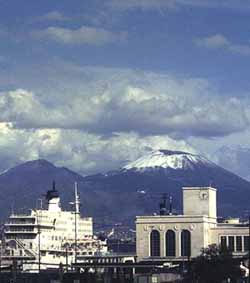 Naples
as Winter Wonderland doesn’t happen too often—once a decade,
perhaps—but it actually snowed at sea level this morning. The
upper elevations of the city, Vomero at 600 feet, were covered with
snow, and the hermitage of Camaldoli at about 1200 feet on the
hill in back of the city looked like a postcard from Austria. Vesuvius,
of course, is appropriately picturesque. Naples
as Winter Wonderland doesn’t happen too often—once a decade,
perhaps—but it actually snowed at sea level this morning. The
upper elevations of the city, Vomero at 600 feet, were covered with
snow, and the hermitage of Camaldoli at about 1200 feet on the
hill in back of the city looked like a postcard from Austria. Vesuvius,
of course, is appropriately picturesque.
Item two:
The morning paper happily notes the presence of some local people in
the new supplement of the Treccani encyclopedia, somewhat the standard
reference work in Italian and the one you have on your shelf when you
want to look something or someone up. The last complete edition came
out in 1997. This year’s update includes, among Neapolitans, Olympic
swimmer Massimiliano Rosolino; author Luciano De Crescenzo; and photographer,
Mimmo Iodice. It includes also, for the first time, a horse!—Varenne,
the trotter (recently retired and happily munching clover somewhere),
winner of 60 races in 70 starts. The paper is unclear on whether or
not Varenne is from Naples and, if so, exactly why he would have a French
name.
Bourbons
(4)
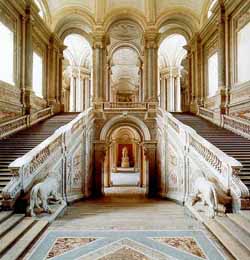 For
those Neapolitans who are tired of traffic, noise, and maybe just the
general daily rigmarole, there are still some genteel pursuits at hand.
One of these is worrying about the problems of the other Charles and
Camilla—of the royal house of Bourbon, the dynasty that ruled
the Kingdom of Naples between the 1730s and 1860. The dynasty, of course,
is, as they say, “in abeyance,” meaning out–of–work.
Carlo and Camilla are what is left of the dynasty, but the princess
is about to remedy that situation in June, when she will give birth.
(I’m really not sure if she’s a princess. It seems to me
that if you marry a prince, that makes you a princess—but what
do I know. I went to the MGM School of History. I’m a barbarian.) For
those Neapolitans who are tired of traffic, noise, and maybe just the
general daily rigmarole, there are still some genteel pursuits at hand.
One of these is worrying about the problems of the other Charles and
Camilla—of the royal house of Bourbon, the dynasty that ruled
the Kingdom of Naples between the 1730s and 1860. The dynasty, of course,
is, as they say, “in abeyance,” meaning out–of–work.
Carlo and Camilla are what is left of the dynasty, but the princess
is about to remedy that situation in June, when she will give birth.
(I’m really not sure if she’s a princess. It seems to me
that if you marry a prince, that makes you a princess—but what
do I know. I went to the MGM School of History. I’m a barbarian.)
Interestingly,
when they were married in 1998, they wanted to have the ceremony in
the great palace of Caserta (photo), that splendid “Versailles
of Italy” built by Vanvitelli in the 1700s. Lamely citing “bureaucratic
obstacles,” the superintendent of said national treasure refused
them that little bit of bizarre, if harmless, counter–revolutionary
nostalgia, so they went to Monaco. The prince kindly directed those
desiring to do so—in lieu of gifts—to donate to the very
active charity in Naples run by Mother Theresa’s Sisters of Calcutta.
This step no doubt raised him a few notches even in the eyes of republican
cynics and those whose only Bourbon acquaintance is Jack Daniels.
For what
it’s worth, the dynastic question is complicated. There is, in
fact, still an operating Bourbon dynasty in Europe in the person of
King Juan Carlos of Spain (born in Rome, by the way), a descendant of
Phillip V, the first Bourbon King of Spain following the Wars of the
Spanish Succession in the early 1700s, and also the grandfather of Charles III, the first Bourbon King of Naples, an
ancestor of the current “virtual” king Charles. This makes
the current Neapolitan Charles and the current King of Spain—let’s
see…carry the two…uh—umpteenth cousins much removed.
However—and here is where it gets interesting—the Spanish
and Italian Bourbons separated into different dynasties in the 1700s,
and depending on how one interprets the subsequent documents that are
said to have ratified this division, the soon–to–be–born
new Bourbon may or may not actually be the king who would some day rule
the Kingdom of Naples if it existed—which it doesn’t.
I think
I’m going outside to check on the traffic, noise and general daily
rigmarole.
Cell-phones
(2)
 The
long, cold Neapolitan winter is over. 'O paese d' 'o sole—“The
Land of the Sun,” as they say in Neapolitan—has returned.
I looked out the window this morning and thought, Oh, no! My eyes
have turned to cobalt—but I'm…so…young. Fortunately,
it was just a bright, cerulean day over the entire Gulf of Naples, and
the only snow left was the white, crystal diadem on Vesuvius. The weather
should stay like this, oh, at least until the day after tomorrow, when
another cold front will move down from Rekjavik. In a scant few tens
of millions of years, the tectonic plate I live on will have pushed
the Alps up high enough to block this sort of illicit cold weather from
the north. I can’t wait. The
long, cold Neapolitan winter is over. 'O paese d' 'o sole—“The
Land of the Sun,” as they say in Neapolitan—has returned.
I looked out the window this morning and thought, Oh, no! My eyes
have turned to cobalt—but I'm…so…young. Fortunately,
it was just a bright, cerulean day over the entire Gulf of Naples, and
the only snow left was the white, crystal diadem on Vesuvius. The weather
should stay like this, oh, at least until the day after tomorrow, when
another cold front will move down from Rekjavik. In a scant few tens
of millions of years, the tectonic plate I live on will have pushed
the Alps up high enough to block this sort of illicit cold weather from
the north. I can’t wait.
Yes, it
was a glorious day to be cut off from the world. They turned off my
telephone. I know that most people already have some sort of chip implanted
in their brains so they are always in contact. They can always call
and be called, disturb and be disturbed, and are evermore bereft of
the inner silence, a silence never jangled by tinny, electronic versions
of Mozart’s Turkish March going off in your molars when
there is “incoming”. I weep for these people, for they will
never know the sense of freedom that I am feeling at this moment.
(Three
hours later)—I have just gone out and bought a cell phone. I couldn’t
take it.
Six words:
Don’t mess with the phone company. (If contractions count as two
words, that makes seven, I know—as in the Seven Last Words of
Christ. My Aramaic friends tell me that a rough translation of those
Seven Last Words is: Do Not Mess With The Phone Company.) All we told
them was that we didn’t like them anymore and were switching to
a more efficient private carrier. Zap. They turned off the ADSL line
a month early and the phone today. I think they can do that, and that
even if I were a centipede, I wouldn’t have a leg to stand on
in any sort of a legal showdown.
I am reminded
of the case, a few years ago, of a Neapolitan doctor, Ermanno Russo.
He had a cell phone installed in his car. He used it primarily to keep
in contact with his patients in the Naples area. His phone bills ran
to about 400–450 thousand lire for the two-month billing period
(In those fine pre-Euro days, that was about 200–225 dollars.
So far, so good. He then got active in politics, ran for office and,
lo and behold, his first phone bill after the election was for one and
one–half million lire. Hmmm, thinks Ermanno, this, too, is possible.
After all, I was on the phone a lot during the campaign.
It is only
when the next phone bill arrives—for three million lire! ($1500)—that
he decides to pay a call on SIP, the phone company. Their records show
that he has called Brazil, Venezuela, Canada, Jupiter and various other
places where, one, he has no patients, and, two, was not running for
office.
"But…but…,"
stammers Russo. "I don't even keep teenagers in my car. How is this
possible? Maybe something has gone wrong with your system!"
He hits
a stone wall quarried in Carrara. Gone wrong? Look, they say, smiling
at him down those long bureaucratic noses of patient disdain,
this is not some fallible human agency you are dealing with. This is
The Phone Company. F as in Father, S as in Son, and Holy
Spirit as in Phone Company. Do you understand? they ask, mouthing
each syllable carefully so as not to overtax their client's limited
mental faculties. They tell Russo, heh–heh, that he should be
more careful about letting others use his mobile phone. Russo
then takes the phone out of his car, field–strips it and trots
the pieces down to the police station, hands them to the coppers and
says,"Here, watch these for me". Then, with his Star Trek walkie–talkie
safely under gendarme lock and key, his next phone bill is for eight
million lire! Then, as they say, the SIP hit the fan.
After furious
electronic sleuthing, authorities traced Russo's phone woes to
a local doctor cum hacker who figured out how to
patch his own phone into the frequencies used by the—at the time—new
cellular telephones. All you needed, he said, was lots of computer smarts
and some sucker's number, and, boy, did he ever have Russo's number.
It started as a prank, said he, and then, as the word spread among his
own circle of freeloading friends, it got out of hand.
These days,
the phone company says not to worry about it. They have the situation
under control. Now, about this swamp land I'm selling…
Hold on.
There goes my molar.
Angevin
Fortress (Maschio Angioino)
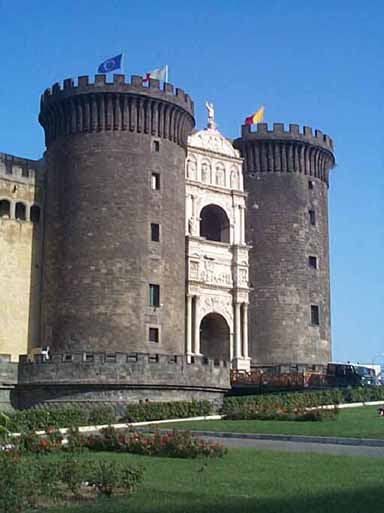 I finally got to take a tour of the Maschio Angioino,
the great Angevin Fortress, down at the port of Naples. It's the first
time that I have actually been in, around and over the premises and
allowed to indulge my inner twelve-year-old—that is, to
get up there on the ramparts behind the battlement where they keep the
merlons, crenels, ballistrarias and bartizan turrets. For those of you
who know less about medieval fortress architecture than you should,
that is the place you stood to pour the boiling oil on the invaders. I finally got to take a tour of the Maschio Angioino,
the great Angevin Fortress, down at the port of Naples. It's the first
time that I have actually been in, around and over the premises and
allowed to indulge my inner twelve-year-old—that is, to
get up there on the ramparts behind the battlement where they keep the
merlons, crenels, ballistrarias and bartizan turrets. For those of you
who know less about medieval fortress architecture than you should,
that is the place you stood to pour the boiling oil on the invaders.
The fortress
is also called the Castelnuovo (New Castle) to distinguish it
from the older Castel dell'Ovo.
It was built by the Angevin King Charles I as the new royal palace when
he moved the capital of the kingdom from Palermo to Naples in the 13th
century. Only a few bits of the original structure have remained over
the centuries, such as the Palatina Chapel. The original structure was
built in only four years and was finished in 1282. It then fell into
disrepair, accelerated by an earthquake; thus, the structure you see
today is a makeover started by the Aragonese in the 1450s and completed
by the Spanish in the mid-1500s.
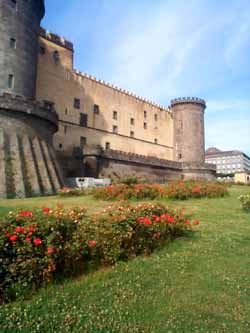 The
castle has seen a number of events highly significant in the history
of the city. In 1294, the castle was the scene of the abdication of
Pope Celestine V. At least in Dante's version of the afterlife, Celestine
resides in Hell. The Divine Comedy places him just past the gates
of Hell among the Opportunists—(in John Ciardi's translation)—"...the
nearly soulless whose lives concluded neither blame nor praise...[and
in reference to Celestine]...I recognized the shadow of that soul
who, in his cowardice, made the Grand Denial...". (To play the Pope's
advocate, I remind you that Dante was really upset at the fact that
Celestine, by quitting, left the door open to the subsequent Pope, Boniface
VIII, corrupt and, in Dante's view, responsible for much of the evils
that befell Dante's city of Florence.) The
castle has seen a number of events highly significant in the history
of the city. In 1294, the castle was the scene of the abdication of
Pope Celestine V. At least in Dante's version of the afterlife, Celestine
resides in Hell. The Divine Comedy places him just past the gates
of Hell among the Opportunists—(in John Ciardi's translation)—"...the
nearly soulless whose lives concluded neither blame nor praise...[and
in reference to Celestine]...I recognized the shadow of that soul
who, in his cowardice, made the Grand Denial...". (To play the Pope's
advocate, I remind you that Dante was really upset at the fact that
Celestine, by quitting, left the door open to the subsequent Pope, Boniface
VIII, corrupt and, in Dante's view, responsible for much of the evils
that befell Dante's city of Florence.)
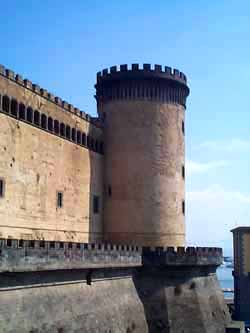 Here,
too, in 1486, the infamous Baron's Plot against the king was brought
to a conclusion with the arrest of the conspirators. Also, in the 1300s,
during the great flowering of Italian medieval literature, King Robert
of Anjou received such eminent poets as Petrarch and Boccaccio. Inside
the castle is a vast courtyard, a 14th century portico, and the elegant
facade of the Palatina Chapel. Although Giotto and his pupils did the
original frescoes inside the chapel, very little of their work remains
today. Much of the sculpture seen on the grounds is from the Aragonese
period (the mid-1400s) and is the work of disciples of Donatello. Here,
too, in 1486, the infamous Baron's Plot against the king was brought
to a conclusion with the arrest of the conspirators. Also, in the 1300s,
during the great flowering of Italian medieval literature, King Robert
of Anjou received such eminent poets as Petrarch and Boccaccio. Inside
the castle is a vast courtyard, a 14th century portico, and the elegant
facade of the Palatina Chapel. Although Giotto and his pupils did the
original frescoes inside the chapel, very little of their work remains
today. Much of the sculpture seen on the grounds is from the Aragonese
period (the mid-1400s) and is the work of disciples of Donatello.
Popular
legend says that a crocodile used to prowl the dungeon; it feasted on
upstart barons who incurred the wrath of the Aragonese king. Accepting
the idea of a renegade Egyptian crocodile jumping ship in the port of
Naples in the Middle Ages and settling down in the castle requires some
suspension of disbelief, admittedly. Yet, it's a good story and no doubt
served to keep potential trouble makers in line. The moat that surrounds
the building was, apparently, just a defensive ditch and was never filled
with water.
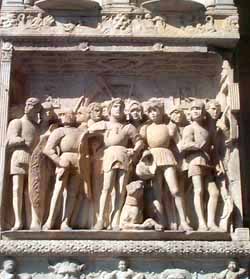 Very
recent archaeology has laid bare the structures that were on the site
before the Angevins moved in to build their castle: (1) the foundations
of a Franciscan convent that was torn down (the residents were given
property for a new convent that still stands, the Church of Santa Maria
La Nova); (2) Roman baths. The site was part of a vast complex running
along the shore to the height of Pizzofalcone and around to the small
isle of Megaride, site of the Egg Castle and presumed site of the villa
of Licinius Lucullus, the Roman consul whose festive life-style has
given us the expression, "Lucullan splendor". Very
recent archaeology has laid bare the structures that were on the site
before the Angevins moved in to build their castle: (1) the foundations
of a Franciscan convent that was torn down (the residents were given
property for a new convent that still stands, the Church of Santa Maria
La Nova); (2) Roman baths. The site was part of a vast complex running
along the shore to the height of Pizzofalcone and around to the small
isle of Megaride, site of the Egg Castle and presumed site of the villa
of Licinius Lucullus, the Roman consul whose festive life-style has
given us the expression, "Lucullan splendor".
As of this
writing, considerable work has gone to opening the fortress to the public
and to push the structure back into the historical consciousness of
Neapolitans. It is, after all, the first royal residence in the city,
even though it was overshadowed by later Spanish palaces and, then,
the great Royal Palace of the Bourbons. At present, The Palatina Chapel
is open, as is the Civic museum, which houses an art collection. Also,
a part of the collection of the Filangieri Museum from downtown Naples
has been set up on the premises while that museum is closed for repairs.
The castle hosts periodic conventions and the Naples City Council convenes
there.
Funiculì-funiculà,
music (4)
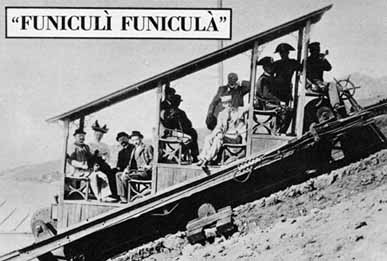 Everyone has had the experience of being obsessed with
and possessed by a melody. It takes you completely unawares—most
likely a little jingle that somehow slipped down behind the sofa cushions
of your mind once upon a time and now, responding to the call of the
mysterious Heavenly Hoover, is sucked up unbidden and unwelcome into
your consciousness. Suddenly you're helpless. You have no control over
your own brain. A diabolical zombie tunesmith is throwing the switches
of your limbic system, gleefully rerouting the same melody over and
over and over, turning your noggin from the crowning achievement of
God's Creation into a useless carousel, wearing grooves in your head
and wasting valuable synaptic connections that could be better spent
trying to remember important things such as the molecular structure
of testosterone, for example. Everyone has had the experience of being obsessed with
and possessed by a melody. It takes you completely unawares—most
likely a little jingle that somehow slipped down behind the sofa cushions
of your mind once upon a time and now, responding to the call of the
mysterious Heavenly Hoover, is sucked up unbidden and unwelcome into
your consciousness. Suddenly you're helpless. You have no control over
your own brain. A diabolical zombie tunesmith is throwing the switches
of your limbic system, gleefully rerouting the same melody over and
over and over, turning your noggin from the crowning achievement of
God's Creation into a useless carousel, wearing grooves in your head
and wasting valuable synaptic connections that could be better spent
trying to remember important things such as the molecular structure
of testosterone, for example.
It is not
clear exactly what it is that gives a tune that ability to move in with
you as wholeheartedly as your in–laws and take over so completely,
but the rhythms of some songs seem to be specially crafted for it. Lilting
little waltzes like Ach, Du Lieber Augustine, for example.
DUM
dee duh duh / DUM duh dum /DUM duh dum / DUM duh dum
DUM dee duh duh / DUM duh dum /DUM duh dum / DUM !
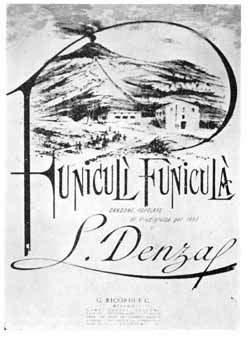 Next
on the all–time list of songs you'll need an exorcist to get rid
of happens to be one of the national anthems of Naples. Unlike many
Neapolitan songs that dwell on unrequited love or warm evenings spent
trying to find the requited kind, Funiculì Funiculà
is a snappy happy little march about going up the side of a volcano.
Almost everyone knows the melody and at least some version of the lyrics,
many of which were written by sniggering boy–scouts when they
should have been practicing their knots and are, therefore, quite unrepeatable
around high class folks like yourselves, so forget it. Next
on the all–time list of songs you'll need an exorcist to get rid
of happens to be one of the national anthems of Naples. Unlike many
Neapolitan songs that dwell on unrequited love or warm evenings spent
trying to find the requited kind, Funiculì Funiculà
is a snappy happy little march about going up the side of a volcano.
Almost everyone knows the melody and at least some version of the lyrics,
many of which were written by sniggering boy–scouts when they
should have been practicing their knots and are, therefore, quite unrepeatable
around high class folks like yourselves, so forget it.
In 1880,
a cable–car, or funicular railway, was opened on the slopes of
Vesuvius; for the occasion, Giuseppe Turco, a noted journalist of the
day, and Luigi Danza turned out the lyrics and melody, respectively.
The melody opens on a lively fanfare interval of a fourth: ta–taah!
and then carries on. The text in the original Neapolitan dialect starts:
"Aissera,
Nanninè, me ne sagliette/ tu saie addò! / tu saie addò!
Addò sto core 'ngrato chiu dispiette/ farme nun pò/
farme nun pò/"
Now the
verse does speak of escaping up the slopes of Vesuvius to get away from
"your ungrateful heart" (it wouldn't be a Neapolitan song without at
least lip service to the doctrine of faithlessness), but the real ambush
comes a few measures later when that famous refrain starts playing raquetball
against the inside of your skull:
"JAMmo,
JAMmo, 'nCOPpa jammo JA…/
JAMmo, JAMmo, 'nCOPpa jammo JA…/
FunicuLI FunicuLA FunicuLI FunicuLAAAA/
'nCOPpa jammo JA… FunicuLI FunicuLAAAAAA!"
What this
means—in a feeble attempt to show that profundity is in inverse
proportion to the square of obsessiveness—is: "LET'S go, LET'S
go, LET'S go to the TOP!"
It works
perfectly. Boy, does it ever. This is the refrain that took the 1880's
crowd by storm, hereabouts. When the funicular started its regular runs
up to the top ("'ncoppa") of Mt. Vesuvius, one imagines hordes of volcano
berserkers hanging out the windows, denting the downbeats into the sides
of the carriages and bellowing "DAAAH–dum DAAAH–dum", winding
up on the inspired open–throated nonsense syllable, "LAAAA!" with
an obsessive ferocity that makes one absolutely nostalgic for the enchanting
strains of "A Hundred Bottles of Beer on the Wall". And unlike the titanic
battle that Mr. Nasenbaum in Beginning Physics swore would shape up
at encounters of this nature, when the irresistible trochaic force of
this song meets the immovable object of your head, it ain't even close.
You get hammered. Undoubtedly, Neapolitan mothers in the1880's spent
much of their time shouting: "Will you kids shut up with that song!"
(Or was it: "SHUT up, SHUT up, SHUT up with that SONG! Damn! Now you've
got me doing it!")
They're
still doing it. And so are the rest of us. I heard it again the other
day and now it's up there, riding the cable–car in my head, going
round and round. The original cable–car, by the way, has been
dismantled. It had been having its ups and downs over the years. There
is some talk of rebuilding it. I can't wait.
CAN'T wait
/ CAN'T wait.
Help.
[Complete
texts in dialect to a number of Neapolitan songs may be found by
clicking here.]
"Nile"
(square & statue); Sant’Angelo
a Nilo (church)
The name
"Nile"—curiously, no doubt—occurs in Neapolitan toponymy.
There is a small Nile Square where you find the Church of Sant’Angelo
a Nilo, as well as a statue of a Nile river god. The church is the
only one in Naples with a name that gives such obvious testimony to
the bonds that the Greek founders of the original city had with their
own cultural forerunners, the Egyptians; the word ‘Nilo’
does, in fact, mean Nile. Here was the ‘Alexandrian (Egyptian)
Quarter’ of the original Greek city.
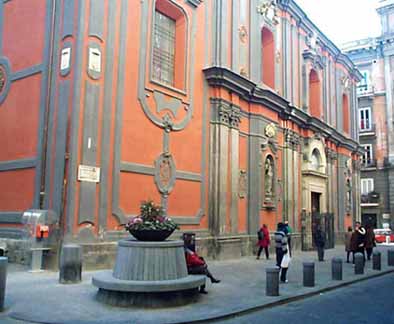 The Church goes back to 1384 when it was built by Cardinal
Rinaldo Brancaccio. Most of the physical structure visible today, however—the
facade, for example—is the result of work done in the early 1500s.
The works within the church bear the stamp almost entirely of the Brancaccio
family, throughout the centuries the only true patrons of this church.
The tomb of Cardinal Brancaccio within the church is one of the most
important examples of Renaissance sculpture in Naples. It was done by
Donatello and Michelozzi in Tuscany, where the executor of Brancacio’s
will, Cosimo dei Medici, then had it transferred to the church in Naples. The Church goes back to 1384 when it was built by Cardinal
Rinaldo Brancaccio. Most of the physical structure visible today, however—the
facade, for example—is the result of work done in the early 1500s.
The works within the church bear the stamp almost entirely of the Brancaccio
family, throughout the centuries the only true patrons of this church.
The tomb of Cardinal Brancaccio within the church is one of the most
important examples of Renaissance sculpture in Naples. It was done by
Donatello and Michelozzi in Tuscany, where the executor of Brancacio’s
will, Cosimo dei Medici, then had it transferred to the church in Naples.
Nearby, the small statue, itself, was restored and cleaned up a few
years ago, but now, again, stands in what looks like a semi-abandoned
state. There is scaffolding on the adjacent building and a tin-roof
shelter has had to be erected to protect the statue; that has proved
to be a convenient stall for a few itinerant vendors. Well, sooner or
later…
To understand
why there should be anything at all in Naples named for the Nile river,
it helps to remember that our inherited body of Greco-Roman myth is
at least partially Egypto-Greco-Roman. There were, for example, at the
time of Christ, a number of Temples of Serapis throughout the Roman
Empire. That Roman cult is directly traceable back through the Greeks
to the Egyptian worship of Isis and Osiris. (However, the so-called
'Temple of Serapis,' in Pozzuoli, we now know, was just a market-place.)
The statue,
this lesser known example of Egyptian influence in Naples, is of an
old merman-like figure reclining on his pedestal. It is at the approximate
spot where the colony of Egyptians from Alexandria settled in the days
of Nero, well after the incorporation of Naples into the dominion of
Rome. Here the Egyptians erected a statue, possibly for veneration,
of the God of the Nile, the river that played such an important part
in the mythology of their own native culture.
The statue
disappeared for centuries following the advent of Christianity in the
Roman Empire. It was not until the 1100s that it was uncovered—headless—during
construction of an early kind of town–hall for the area. (The
name—"Nilo"—of the general area had stuck through the centuries
even in the absence of the statue.) That building was eventually demolished
in the1600s and the statue was moved to the center of the square where
it still stands. At that time a sculptor was hired to add the head;
the statue was restored again in 1734, and a plaque, in Latin, was added
to commemorate the restoration.
Given the
importance of water, particularly rivers, in much world mythology—and
especially the importance of the Nile to the Egyptians—it is not
surprising that settlers from Egypt would have brought the Nile with
them to Naples. They chose a city by the sea, but also one that had
a river of its own at the time, the Sebeto, which then flowed through
the eastern part of Naples.
Even without
the head, the original statue would have been easy to identify as a
chimera, that fantastical patchwork of more than one creature, something
common to many mythologies. It is likely to have been a representation
of Creation, and the original head might have been that of a crocodile,
making it the man-crocodile, Sobek, the Egyptian river God. Possible,
too, is that it was another chimera, Ammut, the god that devoured the
souls of the condemned, and a composite of crocodile, lioness and hippopotamus.
The creature represented by the statue would in both cases have been
similar to those in much sacred literature—"leviathan," in the
Bible, for example, or in Canaanite and Babylonian mythology, where
the Creator conquers a dragon or sea-monster representing primordial
Chaos.
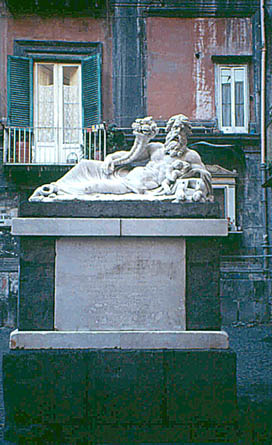 The Nile figure
in Naples is resting on sand, (perhaps rising out of "primordial mud"),
making the "sea monster" interpretation plausible. Yet, in spite of
the paws on the body of the statue— clearly identifying it as
at least part beast—the 17th century sculptor chose to restore
the statue with the head of a man. This might simply have been an attempt
to re–establish the gender of the statue, which many had mistaken
for a goddess of some sort when it was rediscovered. It might, however,
have been a conscious attempt to make the statue resemble the Egyptian
god, Nun, god of the original waters before the Creation and often depicted
as an old man with a beard, a sign of virility. Also, the figure holds
a cornucopia, a widespread symbol of abundance, probably stemming from
'horn' ('corno-') as the symbol of a bull and thus the source of virility,
fertility and abundance—all of which makes the 'Creator' interpretation
just as plausible as that of the 'sea monster'. The Nile figure
in Naples is resting on sand, (perhaps rising out of "primordial mud"),
making the "sea monster" interpretation plausible. Yet, in spite of
the paws on the body of the statue— clearly identifying it as
at least part beast—the 17th century sculptor chose to restore
the statue with the head of a man. This might simply have been an attempt
to re–establish the gender of the statue, which many had mistaken
for a goddess of some sort when it was rediscovered. It might, however,
have been a conscious attempt to make the statue resemble the Egyptian
god, Nun, god of the original waters before the Creation and often depicted
as an old man with a beard, a sign of virility. Also, the figure holds
a cornucopia, a widespread symbol of abundance, probably stemming from
'horn' ('corno-') as the symbol of a bull and thus the source of virility,
fertility and abundance—all of which makes the 'Creator' interpretation
just as plausible as that of the 'sea monster'.
During
the Middle Ages, the square of the Nile became the center of one of
the city's administrative districts ('sedili'), called Tocco
Maggiore, or in Latin, Toccum capitis platae, meaning the
"zone of large houses and wide streets". Since there is an Italian word
very similar to nilo --'nido' (meaning 'nest), which can be taken
to mean 'house'—Nilo was understandably transformed into 'nido'
in the minds of many, thus losing a sense of the original name. It is
still common to hear the square misidentified as 'nido'.
For reasons
that are unclear, the statue has come to be called Cuórpo'
e Napule in Neapolitan dialect (Corpo di Napoli, in Italian)—the
Body of Naples— and the statue and the site have long been objects
of popular 'worship'. The famous 18th-century magician, Cagliostro,
even made a pilgrimage to it. During the recent reconstruction, many
lottery tickets and votive scribblings were found wedged in between
the paws.
Surrounded
by so many later and larger monuments in the downtown area, this small
statue is easy to overlook. Its origin and history, too, are much less
certain than that of more recent artifacts, yet, perhaps that is what
gives it a peculiar charm. In a 2,500-year-old city, there are bound
to be many tiny mysteries that captivate, precisely because they are
enigmatic.
(To
see map of the historic center of Naples: click
here. The church and statue are # 17 and 19, respectively.)
Campi
Flegrei
The
Phlegrean Fields
"The
Breath of the Lord, like a stream of brimstone..."
- Isaiah xxx, 33.
Somewhere
there's a German—(is that a song title?)—who, if he ever
thinks of me at all, remembers me simply as as the joker who gave him
a bum steer (taurus impecuniosus) about the Fiery Fields of Naples,
the Phlegrean Fields, the Campi Flegrei.
We were
sharing a metro carriage, stopped and apparently wintering over in Fuorigrotta,
when I noticed a young man with an Erich von Stroheim scalpcut, dueling
scar and monocle, humming The Ride of the Valkyries under
his breath and holding a guidebook to Naples upside down. I approached
and asked in my best Gothic, "Are you please to be in dire straits of
information, nicht wahr? "
"Zese
are ze Phlegrean Fields, ja?" he snapped.
"Uh, yeah,"
I said, in that authoritative Baedecker baritone that is well-known
to those who know and love me, for I, too, had seen the Campi Flegrei
sign on the station platform. Spent by the intimacy of conversation,
he clicked his heels and got off in gratitude. (I was later to get off
in Bagnoli). As we pulled out, I noticed him noticing that he
was surrounded by Fiats and cement. I last saw him dolefully
rummaging through newsstand post-cards looking for exploding volcanos
and similar stuff that had made Goethe swoon, sturm und drang
a century and a half earlier.
I now know
that I put young Siegfried off the train at least two stops
too early. (Who could blame him if he has since dedicated his life to
taking revenge on unsuspecting tourists by standing outside the
Black Forest Gasthaus in the middle of Hamburg and telling them, "Why,
sure, the headwaters of the Danube are right over there. It says "Black
Forest," doesn't it? Heh-heh-heh.")
Monte
Nuovo and Lake Lucrino in the Campi Flegrei
 The
Campi Flegrei is a cauldron of volcanic origin extending from
the heights of Posillipo in the south to Cuma
in the north and inland a number of miles. It is a welter of extinct
craters, bubbling sulfur pits, underground thermal springs, skewed hills
and sudden jagged upcroppings of tufa and solidified lava. The
Campi Flegrei is a cauldron of volcanic origin extending from
the heights of Posillipo in the south to Cuma
in the north and inland a number of miles. It is a welter of extinct
craters, bubbling sulfur pits, underground thermal springs, skewed hills
and sudden jagged upcroppings of tufa and solidified lava.
The best
way to see this geological freakshow as a single unit is to get
some high ground. Parco Virgiliano is ideal for this. The park
is on the Posillipo ridge overlooking the island of Nisida and offers
a clear view over to the other side of the bay, Cape Miseno, and inland
to the Astroni, which is the wildlife reserve and park above Agnano.
Lake Miseno, by the way, was an important port for the imperial Roman fleet. There is a lighthouse on the
cape, a modern descendant of the one that guided Roman sailors. The
highest point in the Phlegrean Fields is Camaldoli.
It is home to a hermitage, prominently visible from anywhere in the
area, perched as it is, 458 meters above sea-level. It is open to visitors
and offers another clear and broad panorama of the Fields.
Monte
Nuovo (see photo), near Arco Felice, is another remarkable
feature of the Campi Flegrei. The name means "new mountain" and
is entirely appropriate. It was born in a matter of days, beginning
early in the morning of September 29, 1538. In geological terms,
mountains don't come much newer than that, or if they do, try to be
elsewhere when it happens. A Geographical Dictionary of the Kingdom
of the Two Sicilies published in Naples in 1816 recounts that the
eruption destroyed a local town and a hospital. It also cites the proverbial
wisdom that "grass doesn't grow on Monte Nuovo," then points out how
off the mark that bit of folk wisdom is -- there is grass, not to mention
trees, all over Monte Nuovo, says the enyclopedist. (For a separate
item on the geology of the Bay of Naples, click
here.)
Solfatara
is the ever bubbling sulfur pit just south of Pozzuoli; it is one of the greatest tourist attractions
in the area. Sulfur fumaroles vent themselves all over the place, and
you may see entire families out for a Sunday stroll suddenly stop and
run over to one and stick their heads right into the stygian stench.
These are not practitioners of some cult of Neo-Nasal Masochism, for
besides use in vulcanizing rubber, making matches, gunpowder, insecticides
and industrial-grade brimstone to pave the "broad way to destruction"
with, sulfur has putative healing powers, so if the stuff shoots up
right beside the road, free for the snorting, why should you pay for
the privilege at one of the many spas around town? (Also see here.)
Also, if someone has told you to go to Hell recently, Lake Averno is
on the left as you leave Pozzuoli and head north up the via Domiziana.
From World Literature, you will remember that this is the mythological
descent to the underworld, mentioned by Virgil
in the Aeneid. Speaking of which: Cuma, home to Aeneas
after his wanderings and the first Greek settlement on the Italian mainland,
is the last prominent "bump" on the Phlegrean landscape before it smooths
out onto the plain that goes north towards Gaeta. If there is room for
only one cultural "must" on your list, there is something wrong with
you, but, anyway, Cuma is it. For those of you who fall into the psychological
trap of telescoping all ancient civilizations into one convenient mind-frame
(as in: "the ancient Egyptians, Greeks and Romans"), remember that two
thousand years ago, an ancient Roman stood where you are standing and
marveled at Cuma because the ancient Greeks had built it.
The Campi
Flegrei have fascinated travelers for centuries. When Charles Dickens
was here, he said:
"The
fairest country in the world is spread about us. Whether we turn towards
the Miseno shore of the splendid watery amphitheatre, and go by the
Grotto of Posillipo to the Grotta del Cane (Dog) and away to Baiae,
or take the other way, towards Vesuvius and Sorrento, it is one succession
of delights."
A
less poetic view of the Grotto of the Dog is provided by Mark Twain,
who claimed he was all fired up to really try and suffocate one of man's
best friends in the Grotto's famed noxious vapors. He couldn't manage
to chase down a victim. [Click here for
that Mark Twain passage from The Innocents Abroad.] I'm not going
to tell you where that particular place is. Find it yourself. Look for
the metro stop that says Campi Flegrei. Then, ask a stranger.
Floridiana,
Villa
I see that
the City Hall is currently struggling with the demands of environmentalists,
who are demanding that steps be taken to protect one of city's few great
parks, The Villa Floridiana. It is not nearly as well-known as the Villa
Comunale, the Public Gardens, down on the sea-front, or the vast
grounds of the Capodimonte Museum, one of the royal palaces of the
Bourbons from the 18th–century.
For a start, the Floridiana will be put under the auspices of the Naples
Superintendency of Museums, and an initial 150 thousand euros have been
allocated for maintenance and repairs of the grounds. Also, it seems
that the employees of the Floridiana—a dozen or so—like
to use the grounds as their own private parking lot. After all, when
they come to work in the morning, there is generally no place on the
street to park. They certainly can't be expected to use the nearby garages;
they would have to pay, and we can't have that.
 The Villa Floridiana, today one of the favorite public
parks in Naples, commands a pleasant view of the bay from its
position on the slopes of the Vomero section of the city. The villa
dates back to 1816 when Ferdinand I of Bourbon, King of the Two
Sicilies, acquired the property from Giuseppe Caracciolo, Prince
of Torella. The King then donated the property as the site for
a vacation residence to his favorite lady, Luisa Migliaccio Partanna,
duchess of Floridia, from which the villa has taken its
name. (She was the king's "morganatic" * wife and did all right; she
later got a second residence from Ferdinand, the Palazzo Partanna. The
King's first wife, Caroline, died in 1814.) The Villa Floridiana, today one of the favorite public
parks in Naples, commands a pleasant view of the bay from its
position on the slopes of the Vomero section of the city. The villa
dates back to 1816 when Ferdinand I of Bourbon, King of the Two
Sicilies, acquired the property from Giuseppe Caracciolo, Prince
of Torella. The King then donated the property as the site for
a vacation residence to his favorite lady, Luisa Migliaccio Partanna,
duchess of Floridia, from which the villa has taken its
name. (She was the king's "morganatic" * wife and did all right; she
later got a second residence from Ferdinand, the Palazzo Partanna. The
King's first wife, Caroline, died in 1814.)
The neoclassical
residence and surrounding gardens were then planned and built from 1817-19.
Numerous wooded trails wind through the park and there are over a hundred
species of trees, flowers and plants. The original picturesque
and romantic setting was amplified by the addition of statues, fountains,
an outdoor theater, a temple and even a fake ruin or two to heighten
the effect of Classicism. Although much of this original splendour has
decayed, the natural wooded beauty of the park remains, as does the
Villa, itself. The Villa currently houses the Duke of Martina
National Museum of Ceramics (photo), with an important collection of
both European and Oriental items.
*morganatic:
an unusual term with a fascinating etymology, from matrimonium morganaticum,
literally "marriage with a morning gift," referring to a gift given
to the wife on the day of marriage, in lieu of any share in the husband's
property. The term designated a form of marriage in which a nobleman
married a woman of lower social status with the provision that, although
children would be legitimate, neither they nor the wife might lay claim
to the husband's rank or property.
Driving
(4)
"Follow
those who do not drive as well as you do and kill them!"—Attila
the Hun
 Remember
Driver Education? My favorite film in that class was the cartoon about
Mr.Walker and Mr. Wheeler. The former, a good–natured goofy pedestrian,
needed but to slip behind the wheel of his car to have his Jekyll &
Hyde button punched, thus werewolfing into Mr. Wheeler (get it?), crazed
motorist who delights in using his Mercedes–Benzoid hood–ornament
as cross–hairs to mow down little old ladies in cross–walks.
Good stuff, that, and like most wheel–happy adolescents of my
generation, I was one hundred–and–ten percent on the side
of Evil: we all rooted for Mr. Wheeler, much to the dismay of our Driver
Ed instructor. But why listen to a driver with a name like Ed Instructor?
After all, this was the same guy who wouldn't let you shift into high
gear until you got out of the school parking lot. Remember
Driver Education? My favorite film in that class was the cartoon about
Mr.Walker and Mr. Wheeler. The former, a good–natured goofy pedestrian,
needed but to slip behind the wheel of his car to have his Jekyll &
Hyde button punched, thus werewolfing into Mr. Wheeler (get it?), crazed
motorist who delights in using his Mercedes–Benzoid hood–ornament
as cross–hairs to mow down little old ladies in cross–walks.
Good stuff, that, and like most wheel–happy adolescents of my
generation, I was one hundred–and–ten percent on the side
of Evil: we all rooted for Mr. Wheeler, much to the dismay of our Driver
Ed instructor. But why listen to a driver with a name like Ed Instructor?
After all, this was the same guy who wouldn't let you shift into high
gear until you got out of the school parking lot.
Luckily
I have moved to Naples, the Promised Land of wheel–happy adolescents
and now I get to Wheeler out quite frequently. As a matter of fact,
it is getting… more… and more… difficult… to
… change back… don't know… how much… longer
I can… can… hold out…!
(An unspecified
amount of time later.)
(Slap–slap.
Whiskey–whiskey.) Thanks, I needed that. I was saying: I have
done things in Neapolitan traffic, that if I were a traffic cop, I would
chase me down and pull me over, revoke my license forever, tell the
car crusher to leave my vehicle a squat and steaming cube of scrap on
the roadside, and frog–march me in sackcloth to the nearest bicycle
shop.
All this
can be yours. If you want to drive like me, and if you can get them
to let you out on weekends, you have come to the right place. Follow
these rules:
One. Traffic
lights. The only rule about traffic lights in Naples is, "Never run
a green one". I remember a taxi driver telling me in those soft homespun
tones that come naturally when you're accelerating through hospital
zones just what those beautiful colored lights on street corners really
meant to him, sniff, especially at Christmas time: "Sure 'n' 'tis enuf
to bring a tear to the eyes of this son of the auld sod," he whispered.
(Besides traffic lights, he was terrible at geography.) I have actually
stopped for red and been shouted at, on the order of: "Go back to Germany,
you mindless robot tool of the authoritarian overlords! I bet you obey
signs that say No Smoking, Keep Off The Grass, and No Radioactive Waste
Dumping, too! Don't you realize that we are engaged in a ceaseless libertarian
struggle against forces which would squelch individual liberties and
impose…" The rest dopplered down below the range of human hearing
as he sped around me.
Two. You
must absolutely learn to smoke at filling stations. Everyone else does,
even —especially—the guy who is filling your tank. Maybe
he knows something you don't—perhaps that petroleum products are
not flammable, (especially that watered–down brew he's dumping
in your car). I don't care if you're a health nut and have never smoked
in your life, or have sworn off, or think that it's a foul and noxious
vice. Look. Compromise. You don't even have to inhale. (You may not
have time for that, anyway.) At least once in your life you must feel
that top–gun macho rush of adrenalin that comes from lighting
up just as the first whiff of gasoline from the pump hits your nostrils.
True, only God can make a tree, but you can make filling stations explode.
Three.
Learn how to make love in a Fiat 500 (coitus contortius). What, you
rightfully ask, does this have to do with driving? Am I not catering,
nay, pandering to the sophomoric droolers among us to even broach the
subject? You got that right, parry I with Socratic precision. If you
find the whole topic distasteful, you may be interested in a refined
variation. You will need a friend who can drive a fast motorcycle extremely
well, while you sit on the back and lob water–filled balloons
into parked passionmobile through the sun–roofs, which young lovers
inevitably leave open. This is humor of the lowest brow, barely worthy
of early Cromagnon woodshop majors, and, personally, I wouldn't be caught
dead doing it. "Not being caught dead" is the operative phrase, here.
Remember: fast bike, good driver.
Four. Go
the wrong way on one–way streets. When the traffic cop pulls you
over, waggle your cigar, groucho your eye–brows at him and say:
"What's the problem, officer? I was only going one way!" He will chuckle,
tell you some World's Oldest Jokes in Italian and let you off with a
mere blow on the kneecap.
Five. Drive
on side–walks. This is technically legal, since none of the streets
work. Six: Only tourists make U–turns; you should try W's and
B's. There are also a number of letters in the Book of Kells and the
Arabic alphabet worth looking into. This will require study on your
part. Seven: double–park. Eight: triple–park. Nine: Practice
your car horn whenever possible. Remember, that's how Paganini started.
Ten: Remember that silence is golden, yes, but scriptures tell us that
the Great Whore of the Apocalypse will be dressed in gold. You wouldn't
want to look like that, would you?
Valentine's
Day
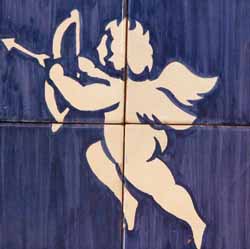 The
worldwide hodge–podging of holidays is careening right along in
Naples. They dress up for Halloween, are already asking me what time
they should be over for Thanksgiving dinner later this year, and I fully
expect Robert E. Lee's birthday and St. Patrick's Day to wind up on
the calendar sooner or later. Yes, little Confederate Leprechauns will
someday take their rightful place—right next to Barbie—in
the traditional Neapolitan representation of the Nativity, the presepe. The
worldwide hodge–podging of holidays is careening right along in
Naples. They dress up for Halloween, are already asking me what time
they should be over for Thanksgiving dinner later this year, and I fully
expect Robert E. Lee's birthday and St. Patrick's Day to wind up on
the calendar sooner or later. Yes, little Confederate Leprechauns will
someday take their rightful place—right next to Barbie—in
the traditional Neapolitan representation of the Nativity, the presepe.
Today,
St. Valentine's Day, is another one of those holidays that no one around
here used to celebrate. At least Valentine is not a foreign import.
He, indeed, was a priest in Rome during the reign of Claudius II Gothicus
in the third century. He was beheaded, they say, on February 14, not
just for refusing to give up his faith, but for refusing to stop performing
Christian marriage rites in an age when Christianity was still a covert
faith. Until 1969, the day was a feast day in the Roman Catholic calendar;
now, however, the secularisation is complete. Paraphernalia of St. Valentine's
Day is evident in all the shops in Naples: stylized bouquets with heart–shaped
candies in place of flowers, €50 heart-shaped boxes of chocolates,
cards, little teddy-bears with the words "Ti amo" ("I love you")
embossed on them, and a special newspaper insert bearing paid–for,
personal declarations of love. There was also an article about the commercialisation
of holidays.
There is
some bad news about Valentine's Day: the heart is not an accurate metaphor
for the emotion we associate with this day. Love is really controlled
by the thalamus, an "ovoid mass of nuclei" in the brain. There is, however,
good news: If you are in love, it doesn't really matter, and, anyway,
it's much easier to make a paper cut-out of a heart than it is of an
ovoid mass of nuclei—and finding even a bad rhyme for "thalamus"
would just about put the Hallmark people out of business. (No, don't
bother. I've been trying for days. So far, I have come up with: "I hope
there's nothing with my gal/pal amiss; won't you be my thalamus.")
 I
was once invited to speak on a "Valentine-related topic". The drab bureaucratic
clunk of that phrase struck me. You can have "work related," "accident
related," "defence related," "budget related," "alcohol related," and
so forth—things which make you tired, sorry or disliked by others—but
I truly believe that you cannot have "Valentine related," without doing
mayhem to the spirit of the season. I
was once invited to speak on a "Valentine-related topic". The drab bureaucratic
clunk of that phrase struck me. You can have "work related," "accident
related," "defence related," "budget related," "alcohol related," and
so forth—things which make you tired, sorry or disliked by others—but
I truly believe that you cannot have "Valentine related," without doing
mayhem to the spirit of the season.
It would
be nice to believe that the day of Lovers is named for Valentine
because he died doing what Lovers do best. Alas, that is not the case.
We associate lovers with his day because of early groups of English
bird watchers. Even back in prehistoric times, they were a race of bird
fanciers. They would stand around the Sceptered Isle in their bowlers
and loin cloths peering through the liquid sunshine at Red or Periwinkle
Breasted or Crested Warblers or Throckmortons. They noticed that birds
took their mates on or about this date. By the time of Chaucer, it was
well established. He recounts in his delightful A Parliament of Fowls,
how all the birds come together on Valentine's Day and discuss which
of them is the best mate. Does love soar like an eagle? Strut like a
peacock? Is it a turkey? Or is it simply quack, quack, waddle over there
and get it done as quickly as possible? In any event, says Chaucer:
For
this was sent on Seynt Valentyne's day
Whan every foul cometh ther to choose his mate. |
Whatever
love is, it is the most besung of human emotions. Read the words of
one known in the 19th-century in America as "The Great Agnostic," Robert
Ingersoll, someone who was honest enough to say that he didn't know
about certain things, but who knew that…
| Love
is the morning and the evening star. It is the air and light of
every heart, builder of every home and kindler of every fire on
every hearth. Love is the magician and enchanter that changes
worthless things to joy and makes royal kings and queens of common
clay. Without that sacred passion we are less than beasts; with
it, earth is heaven and we are gods. |
Islands
This
is less of an island than it is a large unnamed rock sticking up
off the eastern end of Capri. I don't think it is for sale.
|
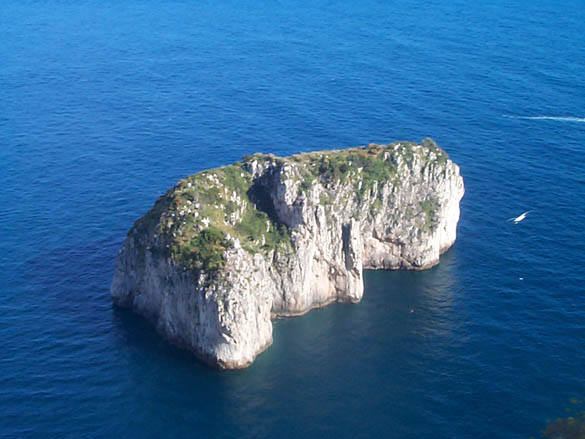 There
are a number of small islands in and around the Bay of Naples that are,
or have been, privately owned. One that comes to mind is the postage-stamp-sized
main island of I Galli (the Gulls). The other "gulls" are
little more than rocks sticking up out of the water, but the main gull
has a grand villa on it. At one time or another, island and house have
been in the possession of the family of Eduardo de Filippo, the Neapolitan
playwright, as well as Rudolf Nuryev, the Russian ballet star. The island
is outside the bay on the other side of the Sorrentine peninsula in the
area where a number of small rocks in the water are named for the sirens
in the Odyssey. At least some of the waters are part of a new national
park, Punta Campanella, named for the tip of the Sorrentine peninsula,
so it is not clear to me whether or not the island is still in private
hands. There
are a number of small islands in and around the Bay of Naples that are,
or have been, privately owned. One that comes to mind is the postage-stamp-sized
main island of I Galli (the Gulls). The other "gulls" are
little more than rocks sticking up out of the water, but the main gull
has a grand villa on it. At one time or another, island and house have
been in the possession of the family of Eduardo de Filippo, the Neapolitan
playwright, as well as Rudolf Nuryev, the Russian ballet star. The island
is outside the bay on the other side of the Sorrentine peninsula in the
area where a number of small rocks in the water are named for the sirens
in the Odyssey. At least some of the waters are part of a new national
park, Punta Campanella, named for the tip of the Sorrentine peninsula,
so it is not clear to me whether or not the island is still in private
hands.
Another
small island is Gaiola off the coast of Posillipo. It has a grim history
and people like to tell you that it's haunted (see here ).
The paper
this morning was worried about the fate of the biggest small island
in the area, Nisida. The current Italian national government apparently
has a bizarre plan to make money by selling off such prime real estate
to anyone with enough money. The Campania region is going to have to
find two million dollars to "buy it back"—meaning, hold on to
it. (For more on Nisida, see here).
|
